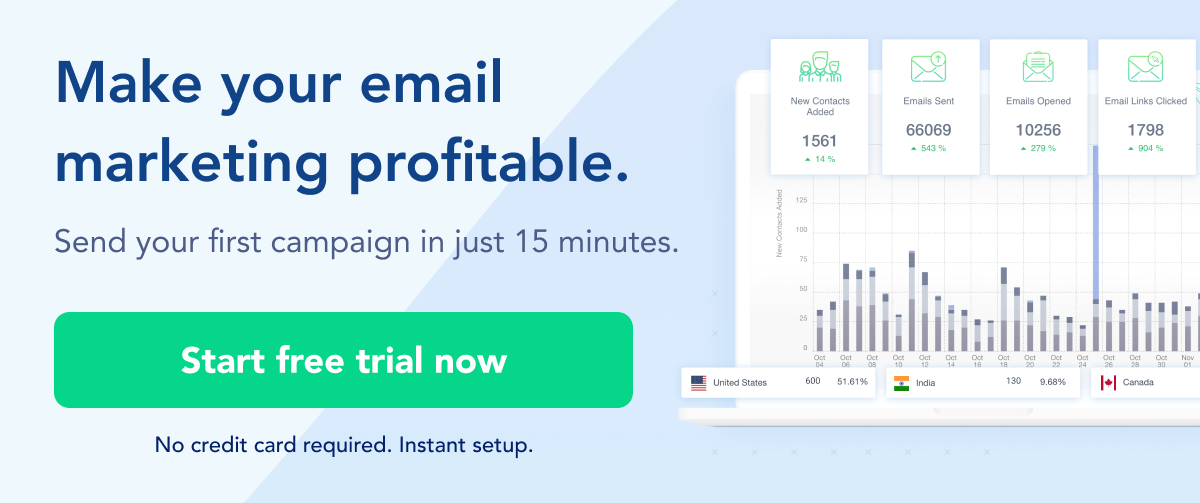To truly harness the power of email marketing, it's crucial to understand how your campaigns measure up against industry standards. That's where benchmarks come in.
Benchmarks serve as a navigational compass, guiding marketers through the vast sea of data towards more strategic, data-driven decisions. Whether you're a seasoned marketer refining your strategy or a newcomer eager to make your mark, knowing these benchmarks is essential for staying competitive and achieving measurable success.
In this blog, we will explore the most essential email marketing benchmarks you need to know. From open rates and click-through rates to conversion rates and beyond, these metrics provide valuable insights into the performance of your email campaigns.
Table of Contents
What Is The Significance Of Benchmarks In Measuring Email Marketing Success?
Benchmarks play a crucial role in measuring email marketing success by providing a set of standards against which marketers can compare their campaign performance. Here's a breakdown of their significance:
- Performance Evaluation: Benchmarks allow marketers to assess how their email campaigns perform compared to industry averages. This includes metrics such as open rates, click-through rates (CTR), conversion rates, and bounce rates. Knowing where they stand helps marketers understand whether their strategies are effective or need improvement.
- Goal Setting: With benchmarks, businesses can set realistic and informed goals. By understanding what constitutes a good open rate or CTR in their industry, marketers can set targets that are ambitious yet achievable, driving continuous improvement in their campaigns.
- Strategy Optimization: By comparing their performance against benchmarks, marketers can identify areas of their campaigns that are underperforming. This insight enables them to make data-driven decisions to optimize their strategies, such as tweaking email subject lines, changing the call-to-action (CTA), or adjusting the email send time.
- Competitive Analysis: Benchmarks also provide a lens through which businesses can view their performance in the context of their competitors. Knowing how well others are doing can motivate businesses to innovate and stay ahead of the curve.
- Trend Identification: Industry benchmarks can reveal broader trends in email marketing, such as increasing mobile device usage or the effectiveness of personalization strategies. By staying informed about these trends, marketers can adapt their tactics to remain relevant and effective.
- Resource Allocation: Understanding which aspects of an email marketing campaign are yielding the best returns helps businesses allocate their resources more effectively. Benchmarks can guide marketers in investing more in high-performing strategies and cutting back on less effective ones.
Is Email Marketing Growing? Let's Look At Some Benchmarks
The landscape of email marketing has seen remarkable growth and transformation in recent years, underlined by a series of compelling statistics that underscore its expanding influence and effectiveness. Amid the COVID-19 crisis, the global email market was valued at an impressive $7.5 billion, with projections suggesting a surge to nearly $18 billion by 2027. This growth trajectory highlights the increasing reliance on and value derived from email marketing across industries.
The volume of global email communication witnessed a significant uptick of 14 percent from 2020 to 2021, a shift initially spurred by the pandemic but now firmly entrenched as part of the "new normal." This increase underscores the adaptability and resilience of email marketing strategies in the face of changing consumer behaviors and global challenges.
In terms of adoption, email marketing remains a cornerstone of digital marketing strategies, with 82% of marketers worldwide integrating it into their comprehensive marketing initiatives. This widespread use is supported by rigorous data collection and analysis, such as that undertaken by Salesforce, which conducted a double-blind survey of 6,950 full-time marketing leaders globally to arrive at its findings. Such methodological rigor ensures the reliability of the data, reinforcing the significance of email marketing in contemporary marketing strategies.
The way audiences interact with email content is also evolving, particularly with the rise of mobile as the dominant platform for email engagement. Currently, 42% of all emails are opened on a mobile device, a figure that escalates among younger demographics—67% for Gen Z and 59% for Millennials. This shift towards mobile highlights the importance of optimizing email marketing content for smaller screens and the varying consumption habits of different age groups.
Consumer preferences further illuminate the central role of email in brand communication strategies. Over half of consumers (51%) express a preference for being contacted by brands via email, more than any other communication channel. This preference, coupled with the finding that the average time spent reading an email has decreased to 10 seconds from 13.4 seconds in 2018, challenges marketers to create concise, compelling content that can capture attention swiftly.
Delving into the infrastructure that underpins email marketing, Gmail stands out as the most popular email provider globally, boasting over 1.5 billion active users as of 2019. In the realm of email client market share, Apple leads with 55.6%, followed by Gmail at 31.6%, Outlook at 4.5%, and Yahoo! at 2.5%. Understanding the nuances between email clients and providers is crucial for optimizing email marketing strategies to reach and engage the broadest possible audience effectively.
Email Open Rate Benchmarks
Email open rates indeed vary significantly across different industries, reflecting how diverse audiences interact with email content. However, one commonality that transcends these differences is the exceptional performance of welcome emails. Across the board, welcome emails consistently achieve higher open rates compared to other types of email communications.
According to reports by Flodesk, welcome emails have a mind-blowing 86% open rate.
This phenomenon can be attributed to several factors:
- First Impressions Matter: When a new subscriber joins your email list, their interest in your brand is at its peak. Sending a welcome email at this moment capitalizes on their engagement, leading to higher open rates.
- Expectation: Subscribers often expect a welcome email upon signing up. This anticipation increases the likelihood that they will open the email once it arrives in their inbox.
- Personal Touch: Welcome emails are often personalized and designed to introduce the subscriber to the brand, making them feel valued and part of the community from the outset.
Transactional emails are lower, averaging between 40–50%.
Abandoned cart email open rates sit at nearly 45%.
Click-Through Rate Benchmarks
This compilation of email benchmarks, provided by Acoustic (previously known as IBM Marketing and Commerce), encompasses data from 750 companies representing 3,000 brands across 40 countries. Here's a breakdown by industry. This approach offers a clearer insight into how your email marketing efforts stack up against peers in your specific sector.
Here are key stats to note:
- Computer Software Industry: For scheduled sends, the computer software industry has a notably high upper quartile for click-to-open rates at 34.4%, indicating that the top-performing emails in this sector achieve significantly higher engagement compared to other industries.
- Financial Services: This industry shows a comparatively low mean click-to-open rate for scheduled sends at 4.6%, which is significantly lower than other sectors, suggesting a more challenging environment for engaging recipients.
- Retail: In the context of automated sends, the retail industry displays a strong performance with a mean click-to-open rate of 12.9%, indicating a solid engagement level with automated email marketing efforts.
- Media & Publishing: For automated sends, the media and publishing sector shows an impressive mean click-to-open rate of 14.1%, suggesting that automated content distribution is highly effective in this industry.
- Transportation: Transactional sends in the transportation industry have a mean click-to-open rate of 7%.
Unsubscribe Rate Benchmark
From the same report, we have unsubscribe benchmarks as well:
- Automotive Industry's High Unsubscribe Rates for Automated Sends: The automotive industry has a notably higher mean unsubscribe rate for automated sends at 0.156%, which is the highest mean rate compared to other industries listed for this type of send. This could indicate that recipients in this industry may perceive automated messages as less relevant or engaging.
- Low Unsubscribe Rates for Transactional Sends in Transportation: The transportation industry shows a very low unsubscribe rate for transactional sends, with a mean of 0.064%. This suggests that transactional emails in this sector are well-received or considered important by the recipients.
- Computer Software Industry's Low Unsubscribe Rates: For scheduled sends, the computer software industry has one of the lowest mean unsubscribe rates at 0.052%. This reflects positively on the industry’s ability to maintain relevance and value in their email communications.
- High Unsubscribe Rates for Consumer Products in Automated Sends: The consumer products industry has a significantly high mean unsubscribe rate for automated sends at 0.445%. This indicates a potential mismatch between the content of automated emails and the interests or preferences of the subscribers in this sector.
- Education Sector’s Varied Unsubscribe Rates: The schools and education sector show a high mean unsubscribe rate for scheduled sends at 0.077%, which suggests scheduled email content may not be aligning with subscriber expectations. However, the rate for transactional sends is not available, indicating a potential lack of data or that such emails are not commonly used or tracked within this industry.
Email Content and Personalization Impact
- Visual Preference in Emails: The statistic that 65% of recipients prefer emails containing mostly images underscores the impact of visual content on user engagement. It suggests that incorporating images into email campaigns can be more appealing to the majority of the audience, likely due to the ease of consumption and the ability to quickly convey messages.
- Personalization Benefits: The data showing that email personalization produces 6x higher revenue and transaction rates demonstrates the value of crafting messages that resonate on an individual level. Personalization can include using a recipient's name, past purchase history, or behavior to tailor the email content.
- Targeting Efficacy: The statistic indicating that proper targeting can drive 3x the revenue per email as compared to non-targeted broadcasting highlights the importance of segmentation. Marketers who segment their lists based on demographics, interests, or behavior can achieve more relevant and effective communication, leading to increased revenue.
- Marketing Automation Adoption: The fact that 75% of marketers use at least one type of marketing automation tool reflects the industry's move towards efficiency and precision. Automation tools can facilitate personalized and targeted emails on a large scale.
- Segmentation ROI: The insight that using highly segmented lists for email marketing returns more than 3x the revenue per recipient versus unsegmented lists reinforces the effectiveness of segmentation. It also echoes the sentiment that targeted communication is more lucrative.
- CTA Optimization: Lastly, the statistic about a call-to-action (CTA) button increasing click-throughs by 28% compared to a text link speaks to design and user experience. A prominent, well-designed CTA button can significantly enhance user engagement and the likelihood of taking the desired action.
Wrap up
The benchmarks provide a roadmap for marketers to navigate the vast and sometimes tumultuous waters of email marketing. Armed with this knowledge, you are better equipped to craft compelling email campaigns that resonate with your audience, drive revenue, and build lasting relationships with your customers. Whether you're fine-tuning your current strategies or embarking on new email marketing ventures, these benchmarks serve as a lighthouse, guiding you towards more effective, impactful, and successful email marketing outcomes.



